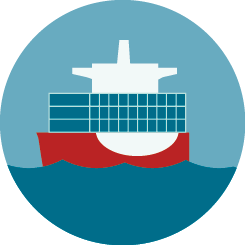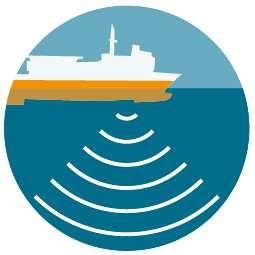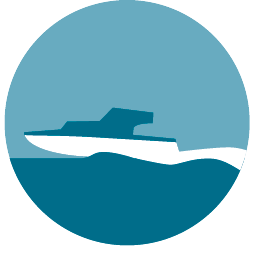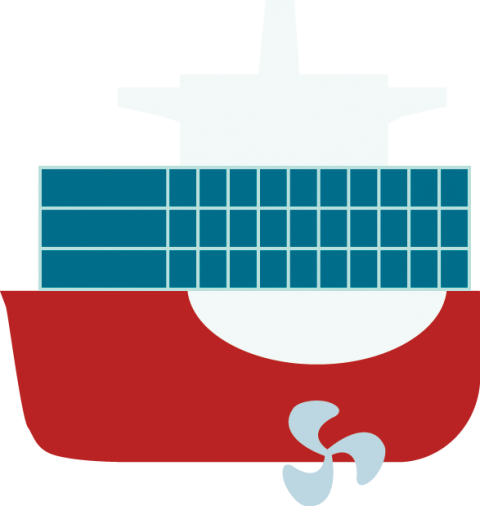Infographic: Underwater noise
The Arctic gets louder
Oceans cover more than 70% of the planet.1 Until recently, the Arctic Ocean’s ice cover made it a natural “acoustic refuge” for marine animals for much of the year.
Major sources of underwater noise6

PILE DRIVING AND OTHER OFFSHORE CONSTRUCTION

MILITARY ACTIVITY

SEISMIC SURVEYS

SHIPPING AND FISHING BOATS

SONAR

WIND FARMS

PLEASURE CRAFTS
Shipping

Where vessel noise comes from
- DRAG FROM POOR HULL MAINTENANCE
- BOW/STERN THRUSTER
- ENGINE AND ONBOARD MACHINERY
- CAVITATION
- PROPELLER
Shipping routes are opening up in the Arctic

90% OF ALL GOODS TRAVEL BY SHIP.7
60,000 commercial tankers and container ships are on the seas at any given time.8
The distance travelled by ships in the Canadian Arctic has NEARLY TRIPLED over the past 25 years.9
Arctic shipping traffic is EXPECTED TO QUADRUPLE by 2025.10
NEARLY 88 VESSELS travelling the Northern Sea Route violated safety rules in 2017.11
Oil and gas

Where oil and gas noise comes from
- REFLECTED ENERGY
- AIR GUN
- SEISMIC BLAST
Oil and gas exploration uses seismic air guns that are 6-7 ORDERS OF MAGNITUDE LOUDER than the loudest ship sounds. The sounds they emit are at frequencies similar to cetaceans’ communication signals, causing confusion among marine mammals and raising the potential for harm.13
Ships equipped with air guns fire EVERY 10-12 SECONDS for weeks or months and THE SOUND CAN TRAVEL FURTHER THAN 4,000 KM.14
Inuit throughout the Arctic say seismic surveys are DRIVING ANIMALS AWAY from their hunting grounds.15
The science of sound
Generally, sound travels about 4.5 TIMES FASTER and 60 TIMES FURTHER in water than in air. It can travel 1,500 metres/second— more than 15 football fields end-to-end.
The underwater soundscape of the Arctic Ocean is affected by ice. It’s quieter in areas with short-fast pack ice and noisier in places with frequent ice cracking.2
In the Arctic, sound travels LONGER DISTANCES and CLOSER TO THE SURFACE compared with temperate oceans.3
Icebreaking ships in the Arctic have a different “noise signature” versus other vessels. DECIBEL LEVELS RISE WHEN SHIPS BREAK ICE.3
Marine animals and sound

Bowhead whales
sing 24 hours per day in the winter to woo mates.

Narwhals
off eastern Greenland spend on average 27% of their time echolocating.18

Walrus
mothers and calves recognize each other by voice. Underwater noise can make it difficult for them to reunite using vocal cues if they get separated.

Beluga whales
lose hair cells in their ears in response to excessive noise.5
The need for protection
ANTHROPOGENIC NOISE affects the ability of fish to locate food, find mates, navigate, communicate and evade predators, and can cause commercial fish species to abandon their habitats.
JUST 5% of the world’s oceans are designated as marine protected areas.17
MORE THAN 3 BILLION people depend on marine and coastal diversity for their livelihoods.16
References
1. NRDC
2-4. WWF, Underwater noise from Arctic shipping: Effects on marine mammals and a need for specific guidelines to safeguard biodiversity.
5. CBC; study was conducted in Tuktoyaktuk (north of Inuvik in NT).
6. Ocean & Coastal Management
7. Vision Project
8. NRDC
9. As of March 2018 – Arctic Today
10-11. High North News
12-13. Yale360
14. NRDC
15. News Deeply
16. United Nations
17. As of Dec. 2016. United Nations
18. Blackwell, S.B, Tervo, O, Conrad, A.,Guldborg Hansen, R., Sinding, M., Heide-Jørgensen, M-P. (2017) Vocal behaviour of East Greenland narwhals. Society for Marine Mammalogy 22nd Biennial Conference on the Biology of Marine Mammals.
Credits
Infographic design by Film & Form // Code by Biome Creative
Audio: NOAA Pacific Marine Environmental Laboratory VENTS Program; Scripps Whale Acoustics Laboratory, UCSD; Thomas R. Kieckhefer / CC-NC
By WWF Global Arctic Programme